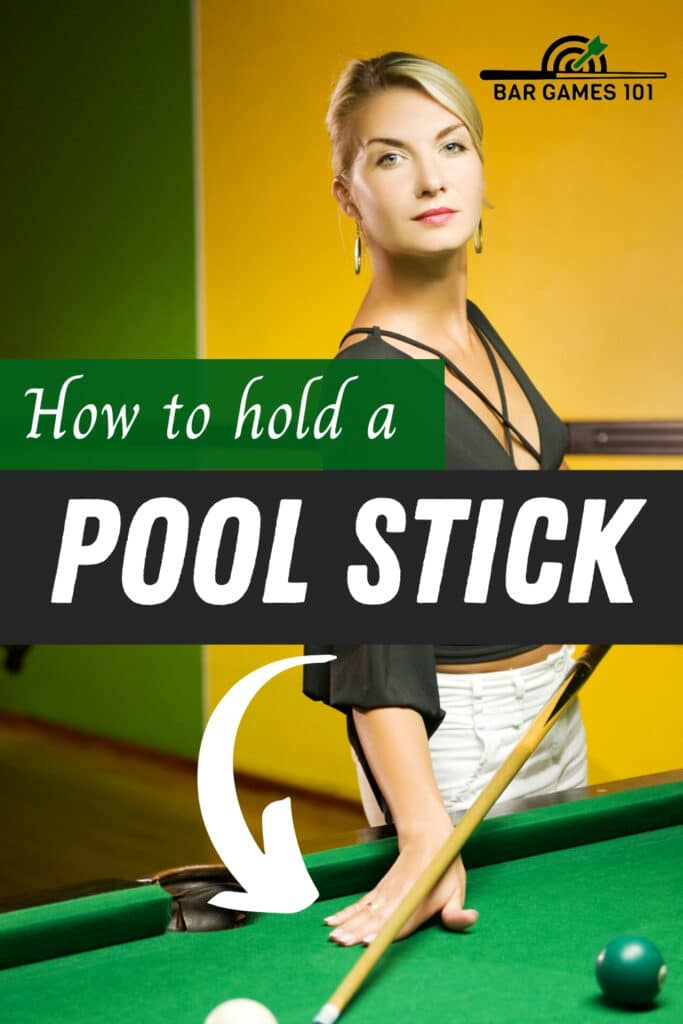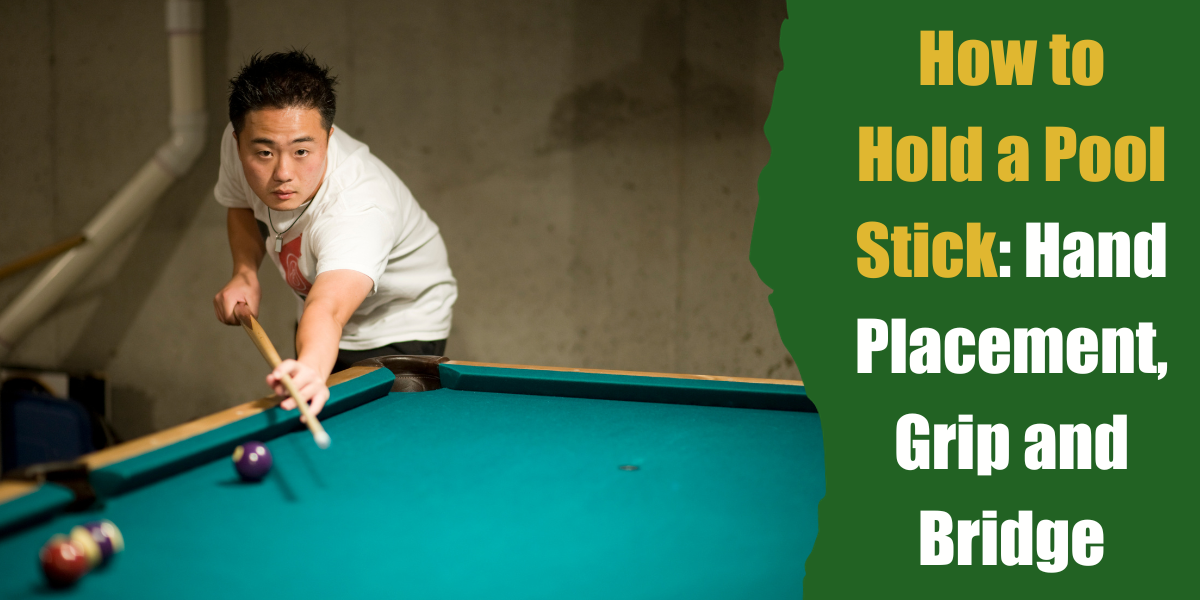Want to know how to hold a pool stick? Let’s clear that up for you with some basic tips on hand placement, grip and your bridge.
Beginner pool players usually don’t want to waste precious time worrying about how to hold a pool stick.
It’s much more fun to grab the pool cue, take aim, nail the cue ball and try to drive your target ball into the pocket.
Good luck with that.
If you skip over the fundamentals of proper grip, stance and alignment, you may not have much success with actually sinking your target ball. Or even hitting it.
You need to start with the basics.
[mc4wp_form id=”6805″]
And one of the most important basic pool skills is learning the proper way to hold a pool cue.
Holding the stick correctly will increase your accuracy, control and power.
In this post, we’ll review the three elements of how to hold a pool stick the right way:
- Where to hold the pool cue (hand position)
- How to grip the pool cue
- How to form your bridge
Each section will begin with a basic rule followed by further explanation.
Master these basic techniques and you will be a better pool player. It’s that simple.
Let’s get started.
New to pool? Also check out the best pool cues for beginners.
1. Where to Hold the Pool Cue
Rule: Your Forearm Should be Perpendicular to Your Pool Stick When Hitting the Cue Ball.
The first step in understanding the right way to hold your pool stick is figuring out where to hold it. This comes down to hand position.
New players usually hold the stick too far forward or too far back towards the butt of the cue.
Finding that sweet spot of where to place your hand may seem like a mystery. But it’s actually really easy.
When trying to figure out where to hold the stick, remember this basic principle: Your forearm should be perpendicular to your pool stick when you contact the cue ball.
So, to check your hand placement, line your cue up so the tip is right in front of the cue ball.
Get the tip close as possible without hitting the cue ball.
Is your forearm perpendicular to your stick at this point?
If not, move your hand accordingly.
Let your forearm hang straight down below your elbow with your wrist in a comfortable position.
This will keep your cue nice and low, which helps with your overall alignment and shot accuracy.
If your arm is a little forward when striking the cue ball, that’s ok.
But your forearm should not be angled back at all when you contact the cue ball.
2. How to Grip the Pool Cue
Rule: Keep your grip natural, light and relaxed.
Now that you know where to hold the stick, it’s time to work on your grip.
First thing’s first: Don’t hold your pool cue too tightly.
One of the most common mistakes beginner pool players make is gripping their pool stick too tightly.
And a tight grip is usually a byproduct of trying to hit the ball too hard.
Many beginner pool players want to strike the ball with force.
Yes, it’s very tempting to try and drive a target ball into the pocket with authority.
Of course, there’s nothing wrong with adding a little oomph with certain shots. But that doesn’t mean you need to grip the pool stick with white knuckles.
And this happens with experienced players, too.
When you’re trying to make a hard shot, it’s natural to tense up.
You wrap your palm around the cue and grip tightly, thinking this will help you exert more control and accuracy.
But whether you’re playing soft shots with precision or trying to hit a hard break, this is absolutely the wrong way to hold a pool stick.
If you hold the cue with a full tight grip, the pool stick will rock up and down during your swing.
This seesaw effect makes it very hard to keep the stick level.
And if you try to force it low and parallel while holding it with a tight grip, you will use more muscles in your arm and shoulder.
This means you lose control of the pendulum swing that relies on a basic back and forth motion with your elbow and forearm. And your shot will suffer.
(Related: The right way to chalk a pool cue)
Always keep Your Grip Natural, Light and Relaxed
If you’ve been gripping your pool stick too tightly, making the change to a light and relaxed grip will make a world of difference.
But there is some debate about how loose your grip should be.
Some players shoot with a very loose grip, using mostly fingers. Others like to rest the stick on the palm lightly to increase control. It may look like their hand is fully wrapped around the stick.
Either way, as world champion 8 ball player Gareth Potts suggests:
A good way to find this natural balance of comfort and control is to lay the pool stick on the table. Now pick it up with the least amount of effort possible. There, that’s how you should hold the stick!
If that’s too simple, there are a few specific pointers that should help.
First, place the cue in fleshy part of your hand between your thumb and index fingers.
Now lightly wrap your thumb and first three fingers around the stick. Your pinky finger can stay loose if that is more comfortable.
The cue should barely touch the palm of your hand, if at all.
With this light grip, your control will come from your index and middle fingers. Your grip should allow the cue to pivot on these fingers.
Some players recommend releasing your middle, ring and pinky fingers during the back stroke.
However, as expert billiards instructor Barry Stark puts it, releasing the fingers is not necessary. Instead, the fingers should just unfurl and re-furl during your swing.
Releasing or unfurling your fingers allows your wrist to stay still during your stroke. This makes it easier to have a straight and level swing.
3. The Bridge
Rule: Use a stable open bridge by cupping your bridge hand on the table and creating a ‘V’ between your thumb and index finger.
Now that you know how to hold a pool stick with a natural and relaxed grip, it’s time to work on your bridge.
The bridge really deserves its own post. To be sure, it usually takes a while to perfect this aspect of your game.
The most import piece of advice when it comes to your bridge is that it should be consistent. Thus, it’s something that needs to be practiced with repetition.
When you find the right bridge for your game, you must stick with it.
There are two basic bridge types for most shots: the ‘open bridge’ or ‘closed bridge’.
The closed bridge is usually best for advanced players who shoot hard shots with lots of spin and action.
Related: Learn more about cue ball positioning techniques.
If you’re a new player, it’s better to work on the open bridge.
To use an open bridge, first place your hand on the table. Now raise your knuckles from the felt by cupping your hand.
This is your base for an open bridge. It should be firm and stable. And you can add stability by spreading out your fingers.
Also, you can raise and lower the bridge as needed by pulling your fingers in, or pushing them out.
Now press your thumb against your upper part of your index finger to form a “V”.
Your cue will rest in the in base of this “V” created by your thumb and index finger.
Whether you use a deep or shallow “V “ is usually a matter of personal preference.
But the contact area between your index finger and thumb should be large enough to firmly and comfortable rest the cue. Then you can use the fleshy parts of your fingers to help guide your shots.
The stick should glide smooth and straight.
With a firm and stable base, this is how you create a comfortable and consistent bridge for the majority of your shots.
Note: If you find you’re reaching too far and can’t set your bridge, it’s time to learn how to use the mechanical bridge.
Learn, Practice and Improve
There you have it. Three basic elements of how to hold a pool stick that, if practiced, will dramatically improve your billiards game.
For further reading on this topic, and many other topics related to beginner, intermediate and advanced pool education, check out this massive resource from Colorado State University.


